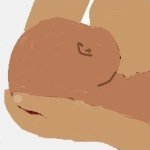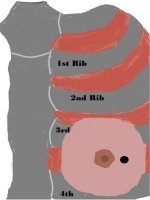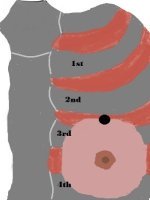
| ||
|
| ||
How to Increase Breast Milk Supply7 methods for increasing breast milk supply. Best StartAn adequate milk supply to meet the infant’s needs will be maintained if the mother and baby complete a physiological labor and stay together with unrestricted access to the breasts after birth. The development of the Mother/Baby Rhythm will also ensure adequate milk supply.However, those goals are not always met, and often an interruption in the cycle decreases the milk supply. This can, and often does, lead to a negative cycle: Formula is substituted for a feed, the milk supply is further diminished, and frustration increases. 
The best solution for increasing milk supply is to put the baby to the breast, frequently, tummy to tummy and skin to skin as often as possible. These points cannot be over-emphasized.
7 Methods to Enhance LactogenesisWarm SoaksWarm soaks to the breast increase blood flow and milk production. Better yet, soak the whole Mommy. A nice, relaxing warm bath would open the blood vessels and the milk ducts in the breasts. Great if you have a nice large tub that allows the mother to submerge her breasts. If not, warm, wet wash clothes over the breasts can be frequently replaced.Herbs to Increase Milk SupplyHerbal products to increase breast milk include fenugreek and blessed thistle. It is often advised to take them together to enhance their effectiveness. Three capsules three time per day is recommended.Herbal teas can also be used, however, it is hard to measure the amount of herb the mother is getting, and she would likely need to drink gallons of tea every day to equal the amount in an herbal tablet. It is to be granted that a tea is more delightful than a tablet, and milk teas to enhance milk supply can be beneficial to a mother. However, if she is in a negative cycle with decreasing milk supply, the tablet form is recommended. Essential Oils and Breast Milk ProductionA circular massage of the breast with a galactogenic essential oil can also stimulate milk flow. Use a 1% solution of Fennel (Foeniculnum vulgare) in a carrier oil such as olive oil or Jojoba oil.A 1% solution of Lemongrass (Cymbopogon citratus) can also be used, though it can cause skin sensitivity in solutions over 4%. Lemongrass should be avoided by women with sensitive skin types. Use of TincturesFennel seed and fenugreek tinctures have been used to enhance milk supply. There has been some debate regarding the use of tinctures, since they do include a small amount of alcohol which will pass into the breast milk. Many advocates would recommend using herbal teas or essential oils instead of a tincture.However, some mothers report more significant effect from the tincture, and it would be agreed by all that the small amount of alcohol in the tincture will have less negative impact than the formula that mothers often reach for when their frustration increases. It is recommended that the tincture be taken several times a day, until its smell can be detected in the urine. Pump and NurseSome mothers have reported pumping from one breast while the infant feeds on the other in order to stimulate an increased production of milk. This has been successful for some, but in other cases mothers with a diminishing milk supply have felt that it decreased the amount of milk their baby was getting per feed.Acupressure for Breastfeeding Acupressure points P-1 and St 16 have been used to increase milk supply and decrease pain. These are convenient to use while the infant is nursing, and can also be stimulated easily between nursing episodes.
Acupressure points P-1 and St 16 have been used to increase milk supply and decrease pain. These are convenient to use while the infant is nursing, and can also be stimulated easily between nursing episodes.P-1 (Pericardium 1 - Tianchiis) one thumb width away from the nipple, towards the outside of the body. (It is at 3:00 on the left breast and 9:00 on the right breast.) While the infant is nursing on one side, the mother can stimulate that point by pressing firmly on P-1 with the thumb on the breast that is not being nursed from. Stimulate this point with sustained, firm, constant pressure for 30 seconds. The pressure can also be applied for 30 seconds at frequent intervals between feeds. The diagram to the left illustrates the P-1 point on the breast tissue.  On the other hand, St 16 (Stomach 16 Yingchuang) can be stimulated on the same side the baby is nursing. This line is directly above the nipple line, but is on the chest wall between the third and fourth ribs – in most cases about where the soft breast tissue ends. It is four thumb breadths from the nipple. Firm pressure from the opposite index finger can be applied to the area above the breast where the infant is nursing.
On the other hand, St 16 (Stomach 16 Yingchuang) can be stimulated on the same side the baby is nursing. This line is directly above the nipple line, but is on the chest wall between the third and fourth ribs – in most cases about where the soft breast tissue ends. It is four thumb breadths from the nipple. Firm pressure from the opposite index finger can be applied to the area above the breast where the infant is nursing.Use firm, constant pressure for 30 seconds and then release. Pressure may also be applied between feeds. The diagram to the right illustrates the ST 16 point. Prescription MedicationsPrescription drugs have been used to increase milk supply. Since prescriptive drugs all have potential negative side effects (that is why they can only be obtained through a medical doctor) this route should be used as a last resort. This has been helpful in certain circumstances, such as separation of mother and baby due to hospitalization.Domperidone and Reglan are the drugs that have been used for this purpose. Domperidone is the preferred drug due to the significant side effects of Reglan and because of its effectiveness. At this time, Domperidone is available in Canada but not the United States. Both are produced primarily for digestive problems but were found to have a galactogenic result as well. Both require a prescription from your physician, nurse midwife, or nurse practitioner. Never ForgetRemember, the very best and most important stimulation for breast milk is a nursing baby. It cannot be over stated that a woman who is capable of producing a full term baby from a single-celled egg is capable of producing enough milk for that baby. If the cycle is interrupted, examine the factors that caused the interruption and see if they can be eliminated.Better Childbirth Outcomes HOME PAGE. |
||
|
|
||
|
By Karen Newell Copyright 2003 - 2012 Better Childbirth Outcomes - All Rights Reserved
Camp Hill, Pennsylvania, USA | ||